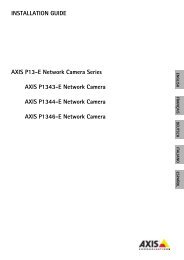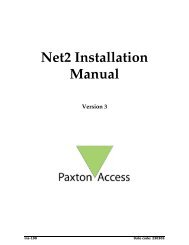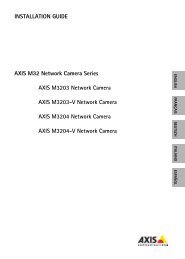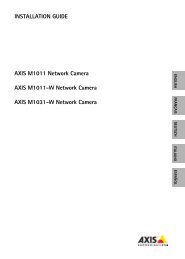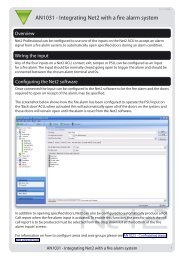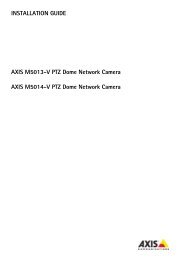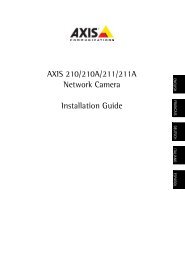You also want an ePaper? Increase the reach of your titles
YUMPU automatically turns print PDFs into web optimized ePapers that Google loves.
AXIS <strong>215</strong> PTZ/ AXIS <strong>215</strong> PTZ-E - Glossary of TermsMonitor - A monitor is very similar to a standard television set, butlacks the electronics to pick up regular television signals.Motion JPEG - Motion JPEG is a simple compression/decompressiontechnique for networked video. Latency is low and image quality isguaranteed, regardless of movement or complexity of the image. Imagequality is controlled by adjusting the compression level, which in turnprovides control over the file size, and thereby the bit rate.High-quality individual images from the Motion JPEG stream are easilyextracted. See also JPEG.Megapixel - See Pixel.MPEG (Moving Picture Experts Group) - The Moving Picture ExpertsGroup develops standards for digital video and audio compression. Itoperates under the auspices of the International Organization forStandardization (ISO). The MPEG standards are an evolving series, eachdesigned for a different purpose.MPEG-2 - MPEG-2 is the designation for a group of audio and videocoding standards, and is typically used to encode audio and video forbroadcast signals, including digital satellite and Cable TV. MPEG-2, withsome modifications, is also the coding format used by standardcommercial DVD movies.MPEG-4 - MPEG-4 is a group of audio and video coding standards andrelated technology. The primary uses for the MPEG-4 standard are web(streaming media) and CD distribution, conversational (videophone), andbroadcast television.Most of the features included in MPEG-4 are left to individualdevelopers to decide whether to implement them or not. This means thatthere are probably no complete implementations of the entire MPEG-4set of standards. To deal with this, the standard includes the concept of"profiles" and "levels", allowing a specific set of capabilities to bedefined in a manner appropriate for a subset of applications.Multicast - Bandwidth-conserving technology that reduces bandwidthusage by simultaneously delivering a single stream of information tomultiple network recipients.Multiplexer - A multiplexer is a high-speed switch that providesfull-screen images from up to 16 analog cameras. Multiplexers canplayback everything that happened on any one camera with nointerference from the other cameras on the system.Network connectivity - The physical (wired or wireless) and logical(protocol) connection of a computer network or an individual device to anetwork, such as the Internet or a LAN.NTSC (National Television System Committee) - NTSC is the televisionand video standard in the United States. NTSC delivers 525 lines at 60half-frames/second.NWay is a telecommunications protocol used to automatically negotiatethe highest available transmission speed between network devices. TheNWay protocol is also known as auto-negotiation or auto-sensing.OEM (Original Equipment Manufacturer) - This is a designation forcompanies that manufacture equipment which is then marketed and soldto other companies under their own names. Quick <strong>User</strong>’s <strong>Guide</strong>PAL (Phase Alternating Line) - PAL is the dominant television standardin Europe. PAL delivers 625 lines at 50 half-frames/second.PEM (Privacy Enhanced Mail) - An early standard for securingelectronic mail. The PEM-format is often used for representing an HTTPScertificate or certificate request.Ping - Ping is a basic network program used diagnostically to check thestatus of a network host or device. Ping can be used to see if a particularnetwork address (IP address or host name) is occupied or not, or if thehost at that address is responding normally. Ping can be run from e.g.the Windows Command prompt or the command line in Unix.Pixel - A pixel is one of the many tiny dots that make up a digitalimage. The color and intensity of each pixel represents a tiny area of thecomplete image.PoE (Power over Ethernet) - Power over Ethernet provides power to anetwork device via the same cable as used for the network connection.This is very useful for IP-Surveillance and remote monitoringapplications in places where it may be too impractical or expensive topower the device from a power outlet.PPP (Point-to-Point Protocol) - A protocol that uses a serial interfacefor communication between two network devices. For example, a PCconnected by a phone line to a server.PPTP (Point-to-Point Tunnelling Protocol) - A protocol (set ofcommunication rules) that allows corporations to extend their owncorporate network through private "tunnels" over the public Internet. Inthis way a corporation can effectively use a WAN (Wide Area Network)as a large single LAN (Local Area Network). This kind of interconnectionis known as a virtual private network (VPN).Pre/post alarm images - The images from immediately before and afteran alarm. These images are stored in a buffer for later retrieval.Progressive scan - Progressive scan, as opposed to interlaced video,scans the entire picture, line by line every sixteenth of a second. In otherwords, captured images are not split into separate fields as in interlacedscanning.Computer monitors do not need interlace to show the picture on thescreen, but instead show them progressively, on one line at a time inperfect order, i.e. 1, 2, 3, 4, 5, 6, 7 etc., so there is virtually no"flickering" effect. In a surveillance application, this can be critical whenviewing detail within a moving image, such as a person running. Ahigh-quality monitor is required to get the best from progressive scan.See also Interlacing.Protocol - A special set of rules governing how two entities willcommunicate. Protocols are found at many levels of communication,and there are hardware protocols and software protocols.Proxy server - In an organization that uses the Internet, a proxy serveracts as an intermediary between a workstation user and the Internet.This provides security, administrative control, and a caching service.Any proxy server associated with a gateway server, or part of a gatewayserver, effectively separates the organization’s network from the outsidenetwork and the local firewall. It is the firewall server that protects thenetwork against outside intrusion.A proxy server receives requests for Internet services (such as web pagerequests) from many users. If the proxy server is also a cache server, itlooks in its local cache of previously downloaded web pages. If it findsthe page, it is returned to the user without forwarding the request to theInternet. If the page is not in the cache, the proxy server, acting as aclient on behalf of the user, uses one of its own IP addresses to requestthe page from another server over the Internet. When the requested pageis returned, the proxy server forwards it to the user that originallyrequested it.PTZ - Pan, tilt and zoom.P-VOP - See VOP.Resolution - Image resolution is a measure of how much detail a digitalimage can hold: the greater the resolution, the greater the level of detail.Resolution can be specified as the number of pixel-columns (width) bythe number of pixel-rows (height), e.g. 320x240.Alternatively, the total number of pixels (usually in megapixels) in theimage can be used. In analog systems it is also common to use otherformat designations, such as CIF, QCIF, 4CIF, etc.RTCP (Real-Time Control Protocol) - RTCP provides support forreal-time conferencing of groups of any size within an intranet. Thissupport includes source identification and support for gateways likeaudio and video bridges as well as multicast-to-unicast translators.RTCP offers quality-of-service feedback from receivers to the multicastgroup as well as support for the synchronization of different mediastreams.RTP (Real-Time Transport Protocol) - RTP is an Internet protocol forthe transport of real-time data, e.g. audio and video. It can be used formedia-on-demand as well as interactive services such as Internettelephony.RTSP (Real Time Streaming Protocol) - RTSP is a control protocol, and49



